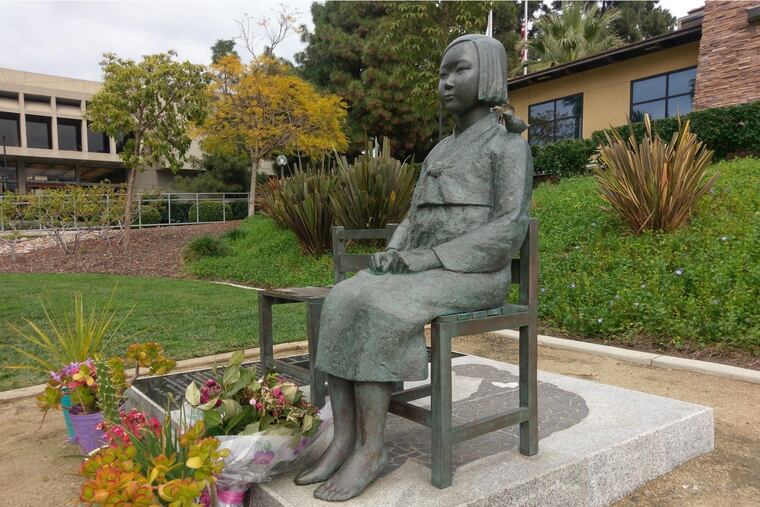Advocates and opponents clash in hearing over Korean ‘comfort women’ statue proposed for Queen Village
Backers say the statue will bring attention to a wartime atrocity. Critics call it divisive.

Advocates and opponents of a proposed Philadelphia statue to honor so-called Korean “comfort women” abused before and during World War II squared off at a hearing Monday, with backers saying the monument would shine light on a historically neglected war crime and critics calling it a thinly disguised strike at Japan.
The fierce debate is over a plan to put up the statue in a small plaza on Front Street in the city’s Queen Village section. The bronze memorial’s main element depicts a mournful-appearing young woman seated on a chair. It is meant to draw attention to how the occupying Japanese army forced Korean women into brothels, beginning in the early 1930s, where they were repeatedly raped by soldiers until the war ended in 1945. “Comfort women” was the euphemism adopted by the Japanese for the victims.
The statue was proposed by a committee of the Korean American Association of Greater Philadelphia. The opposition had been led by the equivalent organization for Japanese Americans in the region.
More opponents than supporters spoke at Monday’s nearly three-hour Zoom session, with many saying that by accepting the statue, the city of Philadelphia would be needlessly taking sides in a geo-political conflict — or, as Patrick Dailey, a leader of the Japanese American Association of Greater Philadelphia, put it, “drawn into an issue better handled by the State Department, not cities.”
But proponents appeared to have won over some key allies. While Mayor Jim Kenney has said he would neither support nor oppose the statue, his administration’s arts agency is backing it. Marguerite Anglin, the city’s public-art director, said the memorial statue near Catharine Street would convey “peace, justice, and healing” and tell “stories that have not been told.”
“The city has statues on wars and commemorating heroes, but does not have statues commemorating the victims of those wars,” Anglin told the members of the city Art Commission who presided over the session. Commission members voted 6-0 to give preliminary approval to the statue last year, but their final vote is scheduled for Oct. 12.
Anglin noted that the city Human Relations Commission had reported no increase in hate or harassment of Asians in other U.S. cities with the statue.
Among others who spoke favorably of the monument was Eleanor Ingersoll, president of the Queen Village Neighbors Association. Her group had formally adopted a position of non-opposition to the statue. In her remarks Monday, Ingersoll had sharp words for the opponents, saying they had “circulated inflammatory and divisive” information and hung leaflet “propaganda” on door knobs.
The opponents pushed back. The memorial “is designed to stoke anti-Japan sentiment and hatred and contempt for Japanese people,” said Edward S. Mazurek, the Japanese American Association’s lawyer.
Four critics of the statue cited what they said were atrocities committed by South Korean troops who fought on the American side during the Vietnam War. They were referencing a more recent debate in which some international leaders have called upon South Korea to officially apologize for sex assaults in that war — much like Japanese Prime Minister Shinzo Abe apologized over “comfort women” in 2015. (Abe was assassinated earlier this year.)
The Philadelphia statue would be a replicate of one first put up in 2011 in Seoul — across from the Japanese Embassy, where it has become a flash point for protest. Since then, 17 statues have gone up worldwide, including six in the United States. The first in the U.S. was installed in Glendale, outside Los Angeles. Japan filed an unsuccessful legal challenge opposing this memorial, asserting that Glendale was seeking to “disrupt the United States’ foreign policy” of encouraging good relations between Japan and South Korea.
A Glendale official has told the The Inquirer that the statue has caused little controversy since.
In the initial language proposed for the plaque with the statue, the proposal says flatly that the women were victimized by the “Japanese Imperial Army.” At the hearing, several critics suggested the language should be broadened in some way.
Shinjoo Cho, who had led the five-year push for the statue, said she was open to reexamining the wording. But she cautioned against those who were engaged in “wishing away the history.”
“No amount of being inclusive, no amount of being historically truthful, will satisfy people who simply want this to go away,” she said.